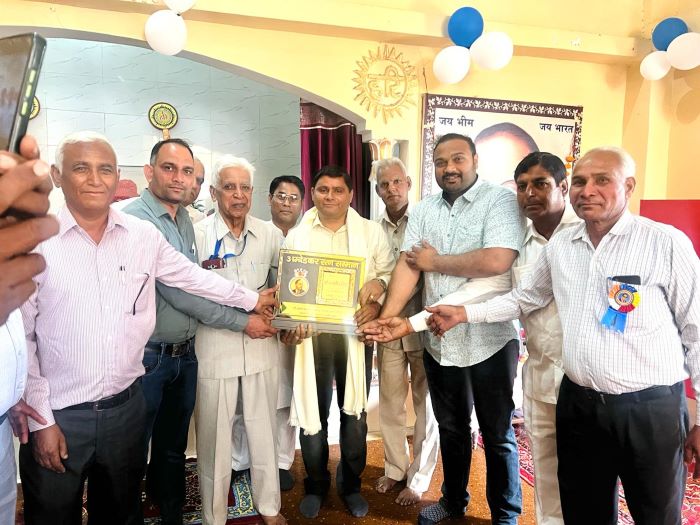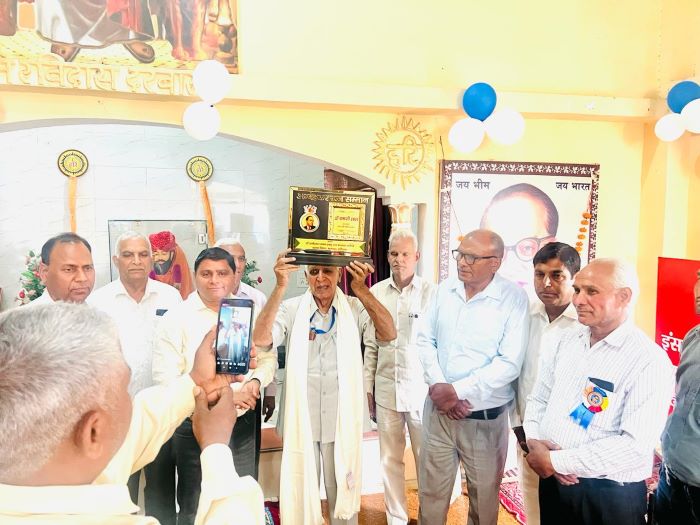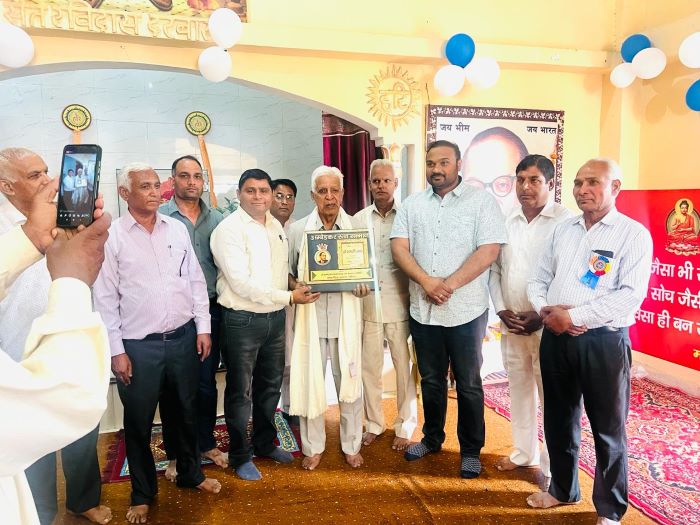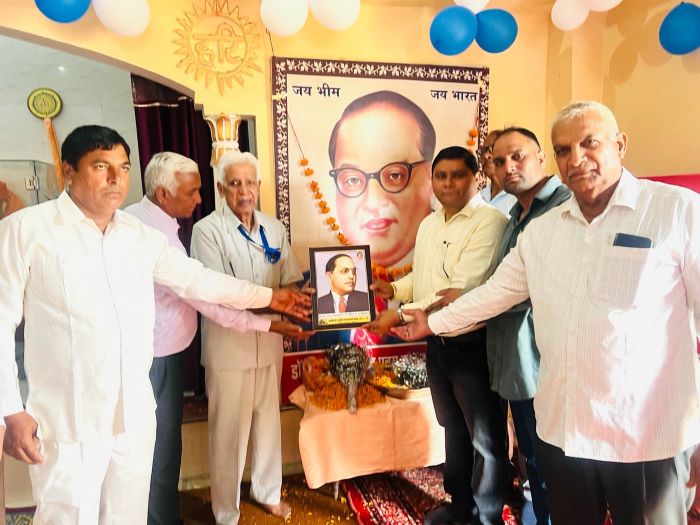Dr. B. R. Ambedkar : As a Journalist
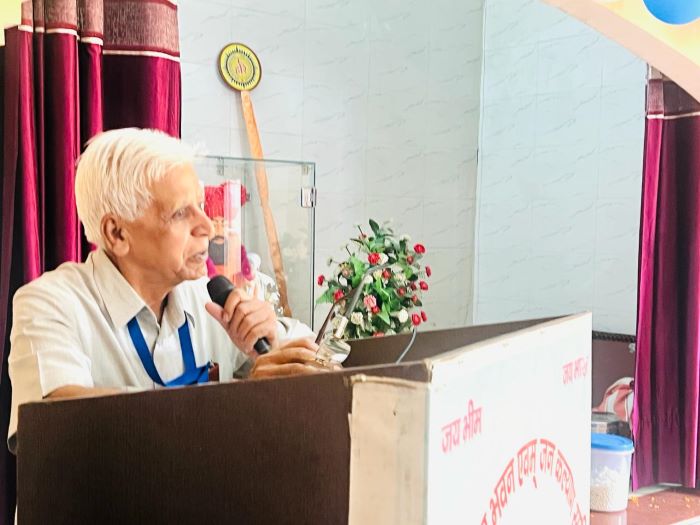 Dr. Ramjilal, Social Scientist, Former Principal, Dyal Singh College, Karnal (Haryana-India).
Dr. Ramjilal, Social Scientist, Former Principal, Dyal Singh College, Karnal (Haryana-India).
email.drramjilal1947@gmail.com
(SAMAJ WEEKLY)- Many social reformers, scholars and politicians have taken birth in the society of Scheduled Castes. In ancient Times, Maharishi Valmiki, in the middle age, Saint Ravidas, Saint Kabir and, in the Asian modern era, Dr. Bhimrao Ramji Ambedkar, Mahatma Ayyankali, Periyar, Gadge Baba, Jagjivan Ram, K.R. Narayanan (10th President of India and the first President belonging to Scheduled Caste), Ramnath Kovind (14th President), Kanshi Ram and, Mayawati.
Dr. Bhimrao Ramji Ambedkar (14 April 1891 – 6 December 1956), Father of the Indian Constitution, Creator, architect and Chairperson of the Draft Committee of the Constitution, famous lawyer, first Law and Justice Minister of Independent India, creator of the Republic of India, linguist, independent and fearless Journalist, bookworm, politician, parliamentarian, Famous economist, social revolutionary, staunch – opponent of social, economic and political-system based On injustice, supporter of abolition of caste and Untouchability, philosopher and thinker, sympathiser of Women, farmers and workers, the advocate and messiah of the untouchable and deprived classes, a great agitator Against society based on disparity and inequality, a High-class struggling thinker and a social revolutionary guide.
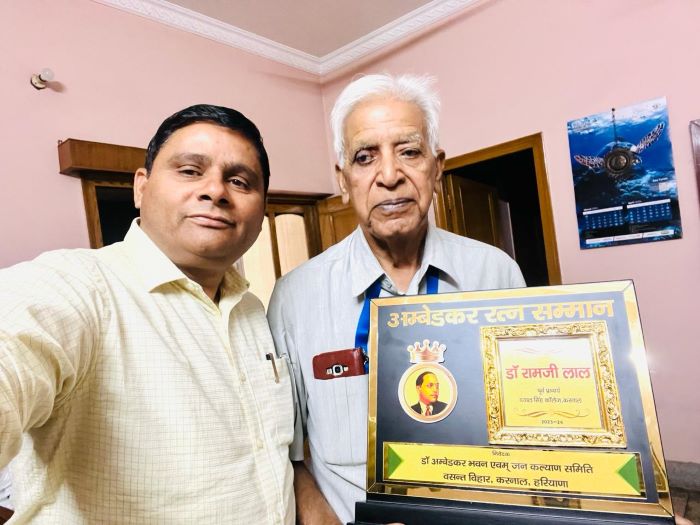 As a social reformer, he was the main advocate of the Abolition of the caste-system, based on Manuvad- Brahmanism. He himself accepted that without the social, economic and political empowerment of women, no Society can improve and develop. From this point of view, he was a pioneer of women empowerment. He is Considered an advocate of equality, liberty and Fraternity. People of the deprived sections of the world take inspiration from the thoughts of Dr. Ambedkar and will continue to do so. This is the reason why his birthday is celebrated every year in about 100 countries of the World. But the ordinary people are not aware that Dr. Bhimrao Ambedkar was also a famous journalist.
As a social reformer, he was the main advocate of the Abolition of the caste-system, based on Manuvad- Brahmanism. He himself accepted that without the social, economic and political empowerment of women, no Society can improve and develop. From this point of view, he was a pioneer of women empowerment. He is Considered an advocate of equality, liberty and Fraternity. People of the deprived sections of the world take inspiration from the thoughts of Dr. Ambedkar and will continue to do so. This is the reason why his birthday is celebrated every year in about 100 countries of the World. But the ordinary people are not aware that Dr. Bhimrao Ambedkar was also a famous journalist.
Dr. Bhimrao Ambedkar: Journalism a ‘Milestone’
Journalism was widely used by national leaders to convey their ideas, principles, news and objectives to the masses in order to raise awareness and mobilize the public for The national movement against the exploitation of the British imperialist government and to achieve independence. Surendranath Banerjee and Dyal Singh Majithia in the 19th century and Lokmanya Bal Gangadhar Tilak, Motilal Nehru, Deenbandhu Rahbar-e- Azam Sir Chhotu Ram, Bhagat Singh, Mahatma Gandhi, Jawaharlal Nehru, Dr. Bhimrao Ambedkar and Revolutionaries, communists and socialists in the Twentieth century. The leaders established newspapers to public awareness and to convey their ideas to the Public. The criticism against British imperialism and Its atrocities was not an easy task. The national leaders were Imprisoned and punished for writing articles in Newspapers. The heavy fines were imposed, offices were Sealed and press was confiscated by the police.
Dr. Bhimrao Ambedkar took the help of journalism to Propagate and spread his ideas, to raise the voice of Dalits, deprived classes and oppressed classes and to make the public aware, educated, organized and agitated against the British government.
Ambedkar’s journalism is a ‘milestone’ in the history of journalism.
Dr. Ambedkar also wrote numerous articles and books on many Contemporary issues. He made journalism a medium of Social change and promoted social, economic and Political justice as enshrined in the Indian Constitution. Equality, liberty, fraternity and dignity of the individual, Justice, basic rights of the individual and democratic values were developed. He believed that the educated class can be a source of inspiration for the silent Audience, which is in large numbers. Therefore, five Newspapers – weekly ‘Mooknayak’, ‘Bahishkrit Bharat’, ‘Samta’, ‘Janta’ and ‘Prabuddha Bharat’ were published in Marathi language for the common people Dr. Bhimrao Ambedkar: Writing Style The style used in journalism by Dr. Bhimrao Ambedkar is exemplary, independent and original in itself. The manner in which problems have been raised, speak volumes of his style. He is precise, logical, revolutionary and rebellious. He tried to make the public aware of the problems facing them and social reforms. Incomparable sharpness, philosophicalness, logic, accuracy, revolutionary and rebellious glimpses are visible in his Literary creation and writing.
For a successful journalist, it is very important to have complete knowledge of the excellence and quality of language. Dr. Bhimrao Ambedkar was great and excellent linguist. He had knowledge of 11 languages – Marathi (native language), Hindi, English, Pali, Sanskrit, Gujarati, German, Persian, French, Kannada and Bengali.
Dr. Bhimrao Ambedkar, while describing the objectives of journalism, said that the main purpose of newspapers is to educate the public, clean their minds, protect them from narrow and divisive sentiments, eradicate communalism and casteism and promote nationalism. Like Bhagat Singh, Dr. Ambedkar also considered journalism as a mission and not a profession. The then main newspaper agency “Associated Press of India” was controlled by the Brahmins of South India. At present, there is control by corporate and government. Almost 100 years ago, the thoughts expressed by Dr. Bhimrao Ambedkar are completely relevant even today because The national main stream media, which should have raised the voice of the public, but raises the voice of Officials, ruling politicians and corporate and is misleading the public. This is the reason why during the farmers’ movement (2020-2021), farmers not only boycotted the mainstream media but also burnt copies of anti-farmers ‘newspapers at the Delhi border and other protest (Dharana) places in India.
The naked dance of this divisive trend has been seen during the farmers ‘movement from 2020-2021. To crush the movement, many tactics were adopted by the Government and its ministers, BJP officials, government
supporters, national, and social media. There were a lot of false and fabricated propaganda against farmers through media. While following the policy of “Divide and Rule”, the Bharatiya Janata Party and its allies, made efforts to create hatred towards farmers in society. New idioms were being used in Indian politics. Every effort was made to divide the citizens and farmers on the basis of religion, caste, language, land, region, class (rich class and poor class), patriots vs traitors, Hindustani vs Pakistani etc.
Farmers were also criticized for calling them terrorists, Khalistani, Naxalites, agitators, parasites, Pakistani supporters, agents of Pakistan and China. Not only this, the farmers were criticized by the so-called national media, electronic media, newspapers, social media, Government, government supporters and journalists. The Farmers were defamed and insulted by calling them anti- national and conspirators. Not only this, but the cassette of Indians vs Pakistanis, Hindu farmers vs Muslim farmers, Sikhs vs Hindus, Muslims vs Christians, fake farmers vs real farmers; poor and small farmers vs rich farmers, farmers supporting agricultural laws vs farmers opposing etc. kept playing continuously. This is definitely contrary to the thinking of Dr. Bhimrao Ambedkar. The
Editors Guild of India criticized this and said that calling the agitating farmers Khalistani or anti-national is against the responsibility and ethics of journalism.
Dr. Bhimrao Ambedkar: Journalism is a mission, not a business.
According to Dr. Bhimrao Ambedkar, the following are The 10 appropriate standards regarding Journalism and Journalists:
”1-Journalism should be free from bias and prejudice.
2. Its special context is caste bias and prejudice in India.
3-Journalism should be based on facts, not on subjective notions.
4-Journalism should be a mission, not a business.
5-Journalism and journalists should have their own ethics.
6-Fearlessness is an essential characteristic of journalism and journalists.
7-It is the duty of journalism and journalists to advocate social interests.
8-There should be no place for personality worship in journalism.
9-The work of journalism is objective reporting instead of sensational news.
10. Instead of provoking the emotions of the public, it is the responsibility of journalism and journalists to awaken their logic and conscience.
(https://samajweekly.com/dr-ambedkar-in-the-context-
of-Indian-newspapers. In short, Dr. Ambedkar, while describing the appropriate standards regarding journalism and journalists, had said that journalism and journalists should be independent of the prevailing Conventions. In fact, journalism should be in the form of a mission and he was completely against the commercialisation of journalism. Regarding journalists, he said that journalists should be fearless, impartial and sensitive, and they should advocate the interests of the society. One should not try to provoke society. There should be no hero worship in journalism. He believed that the educated class could be a source of inspiration for the silent audience, which is in large numbers.
Therefore, five newspapers were published in Marathi language – weekly ‘Mooknayak’, ‘Bahishkrit Bharat’, ‘Samta’, ‘Janta’ and ‘Prabuddha Bharat’.
Dr. Bhimrao Ambedkar: Why were newspapers needed in those circumstances?
Dr. Ambedkar believed that the Dalit class had no Job, no business, and no land and because of being ostracised in the society, it is like a ‘silent hero’. In such a situation, the only recourse they have to raise their voice is through newspapers. Whereas, the then main newspaper agency, “Associated Press Of India” was controlled by the Brahmins of South India. Dr. Ambedkar wrote in clear words:
“The untouchables have no press. The Congress Press is closed to him and determined not to give him even the slightest publicity for obvious reasons. It is disappointing that we do not have enough resources. We don’t have money; we don’t have newspapers. All across India, every day our people are subjected to authoritarianism without any consideration and discrimination; those newspapers are not included. “Through a well-planned conspiracy, the newspapers are fully involved in silencing our views on socio-political problems.”
Expressing his views about the character of the Media at Poona on 18 January 1943, he said, ”I am criticised by the Congress newspapers. I know Congress newspapers very well. I do not give any importance to his criticism. They never refuted my arguments. They know how to criticise, condemn and condemn my every action. They misinform, misrepresent and misinterpret everything I say. Congress papers are not happy with any of my work. It would not be unfair if I said that this hatred and animosity of the Congress papers towards me is an expression of the hatred of Hindus towards the untouchables.”
He further said, ’’People outside India believe that Congress is the only institution that represents India, even the untouchables. The reason for this is that the untouchables do not have any means of their own through which they can assert their claim against the Congress. There are many other reasons for this weakness of the untouchables. The untouchables have no press of their own. Congress press is closed for him. He has taken an oath not to give even the slightest publicity to the untouchables. Untouchables cannot establish their own press. It is clear that no newspaper can run without advertising money. Advertising money comes only from commercial advertisements. Be it small or big businessmen, all of them are associated with the Congress and cannot favour a non-Congress organisation. The staff of the Associated Press of India, India’s news agency, is comprised entirely of Madrasi Brahmins. In fact, the entire press of India is in their hands and they are complete stooges of the Congress, who cannot publish any news against the Congress.
Dr. Ambedkar: As a journalist:
36 years of journey – 31 January 1920 to 4 February 1956 Keeping in mind all the circumstances of that time, Dr. Ambedkar made his debut in the world of journalism. He edited five magazines during his lifetime. A century ago, on 31 January 1920, the first weekly Marathi magazine ‘Mooknayak’ was published. At that time Dr. Ambedkar was 29 years old. An amount of Rs 2500 was given by Sahu Maharaj for the publication of this magazine. He continued doing journalism for 36 years from 1920 to 1956. In these 36 years, apart from Mooknayak’ (31 January, 1920), four other magazines – Bahishkrit Bharat (3 April 1924), (29 June 1928), Janata (24 February 1930) and the last Newspaper edited by him was Prabuddha Bharat (4 February 1956). ‘Prabuddha Bharat’ was closed. But Dr. Ambedkar’s grandson Prakash Ambedkar published the first issue of ‘Prabuddha Bharat; as a fortnightly on 10 May 2017. He believed that the educated class could be a source of inspiration for the silent audience, which is in large numbers.
Therefore, five newspapers were published in Marathi language – weekly ‘Mooknayak’, ‘Bahishkrit Bharat’, ‘Samta’, ‘Janta’ and ‘Prabuddha Bharat’. Through these news magazines, Dr. Ambedkar created awareness among the Scheduled Castes and other marginalised castes of the society. He continuously wrote articles regarding the problems of the Dalit class. He himself wrote the editorial page of Bahishkrit Bharat. In an editorial of Bahishkrit Bharat he wrote that if Bal Gangadhar Tilak had been born in the Dalit class, instead of proclaiming ‘Swaraj is my birth right’, he would have raised the slogan ‘Elimination of untouchability is my birth right’ Babasaheb’s thoughts are absolutely logical and very important in the present context. In India, the capitalist class has complete control over the print media and electronic media. As a result, journalists are not doing their work in the interest of the society. In the present century, print and electronic media are against Dalits, tribes and minorities. Despite this, media persons who have independent views and are treated inhumanely by politicians, administrative officials and police. In In fact, this is an attack on independent thoughts. We call India the world’s largest democracy and Mother democracy. The most important indicator of democracy is freedom of the press. From the point of view of freedom of press, according to the World Press Index Report (2021), India is ranked 142 out of 180 countries. This is the dark side of Indian democracy.
National Media: Participation of Dalits
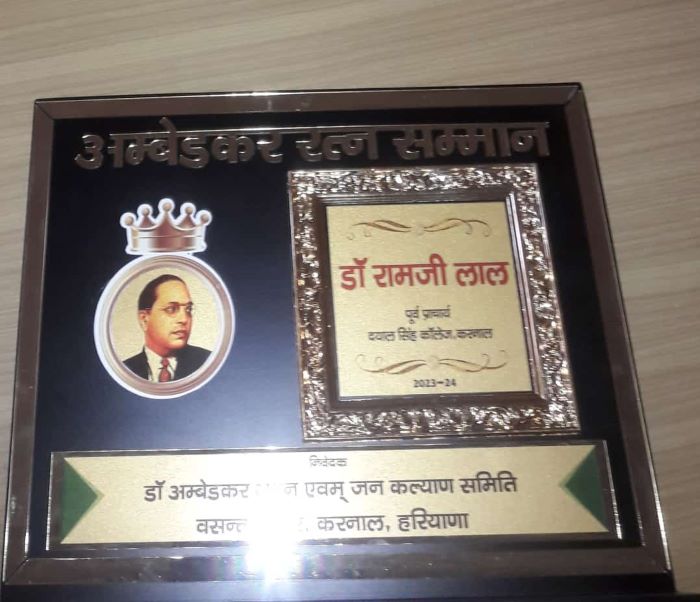 At present the participation of the Dalit class in the National media is less than 1% and it does not raise the problems of the Dalit class. Influenced by the thinking of Dr. Ambedkar, in the present time, the Enlightened people of the Dalit class have operated alternative print media and electronic media – newspapers, magazines and channels to raise the voice of the Dalit class. Currently there are about 150 print and online platforms, including YouTube channels Dalit Dastak, National Dastak, Round Table India, Forward Press, Justice News, Dalit Camera, Dalit News Network (DNN). These plateforms discuss in details the issues related to Scheduled Castes and other marginalised groups of the society. This alternative print and electronic media conveys the voice of the “voiceless class” to the government and are creating consciousness among the Dalit class also.
At present the participation of the Dalit class in the National media is less than 1% and it does not raise the problems of the Dalit class. Influenced by the thinking of Dr. Ambedkar, in the present time, the Enlightened people of the Dalit class have operated alternative print media and electronic media – newspapers, magazines and channels to raise the voice of the Dalit class. Currently there are about 150 print and online platforms, including YouTube channels Dalit Dastak, National Dastak, Round Table India, Forward Press, Justice News, Dalit Camera, Dalit News Network (DNN). These plateforms discuss in details the issues related to Scheduled Castes and other marginalised groups of the society. This alternative print and electronic media conveys the voice of the “voiceless class” to the government and are creating consciousness among the Dalit class also.
(Special comment: Summary of the speech presented in the seminar organised on the birth anniversary of Dr. Bhimrao Ambedkar on 14 April 2024. On this occasion, I was decorated with Ambedkar Ratna Samman. I express my gratitude to Dr. Balbir Singh, (Dyal Singh College, Karnal) former president of Ambedkar Bhavan and Jan Kalyan Samiti and the current executive.)
